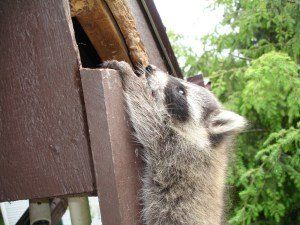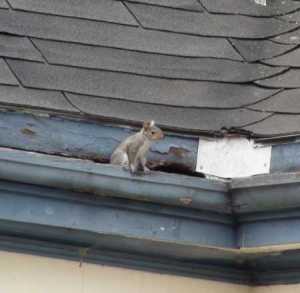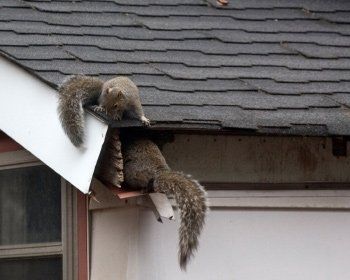Evicting Raccoons & Squirrels From Attics
Nuisance Animals, by law, the Ohio Department of Natural Resources and the Division of Wildlife PROHIBT any wildlife to come into rehab, if the animal has been trapped by a Commercial Nuicance Wild Animal Control Operator (CNWACO) aka Trapper. This includes any babies left behind by the removal of the parent(s) or nursing mother. Keep in mind, when you hire a Animal Control Operator, they will charge you hundreds of dollars to remove the animal and are responsible for killing the animal(s) removed. You can save hundreds of dollars by using humane methods of eviction, or just simply allowing the mother and babies enough time to leave on their own.
Also most animal control operators will also try to charge you hundreds of dollars for the remediation work of the damage caused by the wildlife and are not certified general contractors, therefore not completely solving the issue of why the animal because a "nuisance" in the first place. Here you will find Humane Eviction methods that you can do yourself, but leaving nature alone is the best option and allowing the animal to vacate your premise on their own terms.
Raccoons: Raccoon mothers nest at least six foot off the ground with their babies. Sometimes this means at the top of a tree, the roof line of a garage, the attic, the roof of an apartment complex, etc. Squirrels nest up high too, but never at the very top of a tree where they would be exposed to weather, and predatory birds. Raccoons are born from March through June, and again from August through September in the Midwestern US. Mothers give birth to 3-6 babies, which are technically called ‘kits’ but we’ve been known to call them cubs, pups, kids, and a million other things. When born, they are grey in color with their eyes closed, and without the telltale raccoon ‘mask’ on their faces. Over the first six weeks these babies will go from looking like this to 2-3 lb miniature raccoons. It all happens very quickly. Mothers do not always return to their nesting site from year to year, but daughters frequently reuse the nesting site where they were born, and neighboring raccoons are more than aware of where the nesting sites are in their area.
Squirrels: Squirrel mothers prefer a medium high nest at 8-12 feet with good overhead cover. These spots include trees with foliage, attics, garages, cable boxes, electrical boxes, telephone poles, and even flagpole tops. Squirrels are born from February through April, and again from late July through October. Normally Mom births 3-6 babies in a litter. They are born hairless and pink, with their eyes closed, and looking more like an alien than a squirrel. Over the first six weeks they will change drastically and become juvenile squirrels which look extremely similar to adults aside from a slightly lesser body weight. Mother squirrels frequently reuse nesting sites from litter to litter and year to year. If a mother does not return to a pre-built nest, it is often taken over by birds or 4138804483_95bee44cd5_oother squirrels in the area that are in need of a place to stay.
Just about every animal is adorable when they are young, but less so when their noise is keeping you up at night, and they’re living in the attic. Cute or not, they must go! We prefer to do this humanely, effectively, simply, and frugally by ‘evicting’ families instead of ‘removing’ or ‘relocating’ them. It’s easy, it works, and it will save their lives and you a ton of money that you would have spent on pest control! On the next few pages, we will teach you the steps necessary to keep the wildlife around you outside – in the wild, where they belong.
Note: If young are present, the most humane thing to do is to leave the family alone until they move on their own. Anytime you try to evict a mother animal and her young there is a chance that she may leave some or all of her young behind. If the young end up as orphans they will not survive in the wild without mom. In these cases, they should be taken to a wildlife rehabilitator. Call us at (513)601-9617. Do not attempt to care for the animals yourself. Not only could you further harm the animals, it is also illegal for you to do so. The longer that you wait to begin the eviction process, the older the young will be, and the more successful your eviction will be in turn.
Supplies Needed:
□ One gallon bottle of ammonia (NOT ‘Lemon Fresh’ or scented. We want it to smell like ammonia.)□ 6-12 old wash rags or similar sized cloths that you are willing to throw away□ 6-12 Ziploc or similar gallon-sized, seal-able plastic bags□ Battery Operated Radio (or long extension cord)□ Battery Operated Light or Lantern (or long extension cord) If no light in attic□ Battery Operated Fan (or long extension cord) If no attic fan□ Red, powdered Cayenne Pepper, found in the grocery store salt and spice aisle□ Newspaper or old unused wrapping paper□ Laundry basket (for raccoons) Wicker basket or ice cream bucket (for squirrels)
01
Find Home Base
Take a walk around the outside of your home. Look at the eaves, the roof line, the roof and shingles that you can see. Are there any obvious areas that need repairs? Is there a chimney cap blocking the top of your chimney, or is it open for anyone to get in? Do you see a particularly dirty area on your brick or siding? Tracks on the ground, feces piles, stray hairs, and nesting materials may be found outdoors as well. If the walk doesn’t tell you much, wait until the sun is out and brightly shining and open the door into your attic (on your ceiling in the house). Stand on a ladder or step stool and only stick your head up there to look around. We promise, Momma is not going to attack you! She’ll hide, or she might leave through the entrance that we’re looking for! Don’t try to be sneaky. We’re not trying to sneak up on her, and we’re not going up there yet. We just want to look around. Look for any areas where you see light coming into the attic. Also look for insulation that is dirty, patted down, disheveled, or just different than the rest. Listen for noises of babies. They usually sound like little bird noises when they are young. Once you have located the entry point, we’re ready for Step Two.
02
Stinky Business
Soak at least 5 of the rags on the supply list in the Ammonia. Wring out the rag slightly, but leave it very wet, not dripping. Place one soaked rag into each Ziploc bag and seal it. You should have 5+ sealed bags each with a soaked, stinky rag inside. Use a fork or knife to poke holes in each bag to allow the smell to seep out. *Ammonia is a lot like alcohol in that it dries very quickly. Instead of replenishing the wet rags constantly, we use Ziploc bags to slowly dispense the smell without having to replace them when they dry out. These bags should remain stinky for 3-5 days depending on how hot it is. Pop you head up into the attic when you think Mom isn’t home, raccoons at night, squirrels during the day. (It doesn’t really matter. She’s not going to attack you.) Throw your ammonia rag bags in each corner of the attic, plus one in the middle. If you know where the nest is, feel free to concentrate your efforts on that area instead. If you have a huge house, expect to use more bags. Turn off attic fans, and close the door to the attic. We want the smell to fill the air in the attic. You shouldn’t smell it in the house at all. Mom will though, and she won’t want her babies to breathe that in, leading her to start looking for a new apartment.
03
Light ‘em Up!
Momma Raccoon wants her kids to be surrounded by darkness so that they are protected from predators, and the lack of light also reassures her that you haven’t found her secret yet. Squirrel Moms need their sleep at night and every little light change wakes them up to investigate what’s going on. Either way, repeated lights blinking or just staying on all the time, are beyond annoying to any tired, overworked Mom trying to get enough sleep and keep her kids safe. If you have a light in the attic, with a switch downstairs, this is easy. For raccoons, turn the light on at night and leave it on. Between you and the sun, she will never get any dark time and this will help convince her that this isn’t where she wants to be. For squirrels: Starting at sunset, flip the light switch on every time you happen to walk by the switch. Encourage the whole family to do it. Flip the light on, then count to five and turn it off again. Every time you do this, you interrupt Mom’s sleep schedule. You can imagine how annoying that would be after someone does it 10x when you’re trying to sleep. If you do not have a light switch, try using a battery operated lantern, or a bright light on a surge protector or extension cord. To turn them off and on you can unplug the cord or flip the switch on the surge protector.
04
If it’s Too Loud, You’re Too Old.
Raccoon and squirrels both have amazing hearing abilities. They are especially on alert when they have nursing young that are vulnerable to everything and that they must protect. Every little noise wakes them from a deep sleep. Every rustle, creak, thump, and rattle is heard and noted by Mom as a potential threat or not important. The point is to make her uncomfortable until she willingly relocates herself and the babies. Using a battery powered radio or an extension cord from downstairs, turn on the loudest, harshest music that you can find- hard rock, techno, rap, rock, etc. Some say that talk radio works just as well. Turn the music up to the loudest volume that your neighbors will tolerate and point the radio in the direction of where you believe the animals are nesting. Make sure you play it when Mom would be sleeping. For squirrels the best time is from dusk to dawn, and for raccoons it will be more effective from 7am – 10pm.
05
Check Your Work
Stuff newspaper or wrapping paper into the main entry access point. Don’t try to keep her out entirely, but pack it well enough that Mom has to use some effort to clear it away. This way, you’ll see the newspaper on the ground or at least tampered with when she has gone out or come back from her little hideaway.
06
What Success Looks Like.
If you are successful with any of the above methods, you will soon see a Mother squirrel or raccoon darting out of your attic carrying a baby in her mouth. Sometimes this happens as quickly as one hour after beginning the eviction process. This process is absolutely critical for you and the family of animals. Stay out of her way. Keep children and pets AWAY from the general area where Mom is coming and going. Better yet, keep children and pets indoors while this is all going on. Mom can only carry one baby at a time, which means that she will have to make multiple trips to get all of her kids out of the attic. You DO NOT want to come between Mom and her kids. She can create a lot of havoc and do a lot of damage to your home if she gets separated and wants her babies back. Let her have time to get all of them. The next day, a full 24 hours after Mom left (the next evening for raccoon, the next day for squirrels) it is safe to enter the attic. Wear gloves, or take a towel with you, along with a small basket or box (even an ice cream bucket) that is easy for you to carry. Again, do not attempt to try to sneak up on anyone in the attic. Make noise, use a flashlight, and look around before proceeding slowly. Most importantly, listen! Babies make noises like birds, and after 24 hours without Mom they will be making some kind of noise. Locate the babies and use gloves or a towel to pick them up and place them in a box or basket. Make sure that you listen closely for movement and/or growling. This could be Mom. If you think that you hear her, put the box or basket on the ground and head out of the attic calmly. Otherwise, bring the babies downstairs and contact a wildlife rehabilitator for further assistance.
07
The End of the Road.
You did it. You successfully evicted the furry tenants in your attic. Just one problem – the rest of your wild neighbors think that your place is now up for grabs and accepting new Raccoon on the roof. It is absolutely, 100% imperative that you repair any and ALL of the entry points where animals can access your home. Do everything that you can to make your home unattractive to further visits from our furry friends. Try using this checklist to make sure you have covered all of your bases. This list should be checked annually, if not seasonally.
08
Remember
□ Never feed raccoons.
□ Pick fruit as soon as it ripens.
□ Regularly pick up fallen birdseed and use baffles to keep critters out of bird feeders.
□ Keep barbecues clean and covered when not in use.
□ Secure garbage indoors until collection day.
□ Keep compost in containers that keep raccoons out while allowing for ventilation.
□ Block off all potential access points to your attic, garage, sheds, and other buildings.
□ Secure the perimeter of decks, sheds, and crawl spaces.
□ Keep indoor pet food and any other food away from a pet door. Lock the pet door at night.
□ Install a chimney cap.
□ Install a dryer vent screen.
□ Trim branches near buildings to prevent easy access to the roof.
□ Complete home repairs in the autumn, so mother and young won’t be trapped inside.
□ Consider installing a “Scarecrow” device that is a motion activated sprinkler to deter animals from coming into your yard or on your property.
□ Install motion activated flood lights.




















































